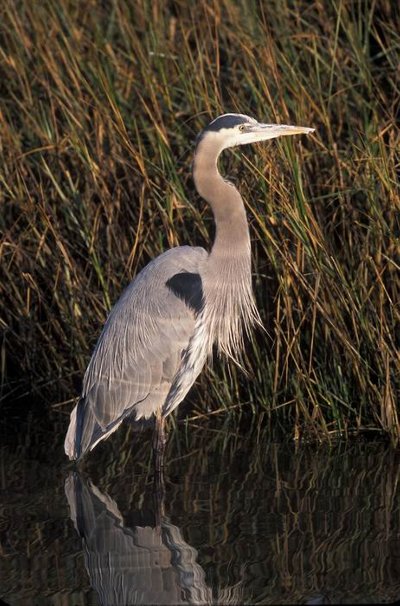
A very special caller has been helping us out on the farm of late. The visits are usually in the early morning hours just before dawn and again at dusk. We see him most often at the little fish pond in the front yard, standing motionless and alone. Wary and alert, he waits for prey to come within range of his long sharp beak.
Standing about 4 feet tall, long-legged with dusky light feathers floating above the thicker gray-blue feathers of his back and neck, he will begin a slow, measured gait away from the pond. Moving at a snail's pace towards the nearest gopher hole he suddenly strikes with a speed so great you can barely see his head move forward, and then he is back in position again with a vole or gopher proudly displayed in his beak. Then whoosh down the gullet it goes. Ahhh, breakfast!
Sometimes called Big Cranky, Long John, or Poor Joe, and often called the blue crane (although related, herons are in a different taxonomic family than are cranes), the great blue heron is the most common and largest of North American herons and one of the most widely distributed, breeding from southeastern Alaska to Nova Scotia and southward across the continent to Mexico and the West Indies.
Standing some 3 to 4½ feet tall and sporting a wingspan of nearly 6½ feet, great blues are a great joy to see in flight, often cruising at a speed of 20 to 30 miles an hour. As nature would never be without irony this beautiful bird, majestic in flight and displaying movements on the ground measured with the precision of a Swiss watchmaker, has a flight call that can only be described as a cranky honk, and when startled it produces a low pitched croak sounding much like grandpa waking from a deep sleep.
Great blues prefer to nest in colonies in very tall trees but will also nest by themselves in low shrubs. Typically their nests are flimsy, flat platforms of sticks about 18 inches across, but well-used older nests can be very bulky and measure 3 to 4 feet across. These older nests are generally repaired and used year after year, and may be lined with twigs, mosses, pine needles, reeds, and marsh grasses.
Generally, nesting occurs between March and May. The birds will lay three to seven eggs that are a pale blue-green to olive in color.
Both parents will take turns incubating the eggs and feeding the nestlings; when newly hatched, the nestlings are fed by the parents regurgitating food into the mouths of the chicks (usually fish) and then later onto the nest floor.
The young will start taking sustained flights around the nesting grounds 60 days after hatching and will abandon the nest between 65 and 91 days after hatching.
Great blues typically live between 10 and 21 years.

The great blue heron is protected by law and may not be kept in captivity without a permit. Adult great blues have few natural enemies. They are occasionally preyed upon or attacked by hawks or owls, but predation is not a limiting factor on their populations. The eggs and young can be heavily preyed upon in the nest by crows, ravens, hawks, owls, gulls and raccoons.
Historically populations of great blue herons were adversely affected by shooting and collecting of their plumage for fashion (for plumed women’s hats) and egg collecting, as well as by the extensive loss of wetland habitats in the U.S. within the last century.
Changing attitudes and the regulation of wetland losses in recent years have allowed great blue heron populations to recover and stabilize throughout much of the species’ range, though the potential for human-caused declines still exists.
As urban sprawl claims more of our beautiful landscape year after year, you can bet that wherever the interests of humans and wildlife collide the great blue heron is a good indicator of the environmental health of its region.
As one of many top-level predators, great blue herons cut a high profile within an ecosystem. These birds require wetland areas that are relatively disturbance-free for nesting, while feeding in both aquatic and terrestrial habitats throughout the year.
Environmental landscapes that support great blue herons clearly have many elements required to support a variety of other wildlife species.
Because they are waders and expert fishers the great blue heron is typically seen along coastlines, in marshes, or near the shores of ponds or streams. Their diet consists primarily of fish, but they also eat amphibians, reptiles, insects, crustaceans, and sometimes small mammals and birds.
They are often seen around rice fields, in open pastures (especially when wet), along creeks and in protected wetlands, or in my front yard eating the voles and gophers.
Debra Chase is the Executive Director of Tuleyome. She and her husband Dave reside on their farm in Colusa County. Tuleyome is a local nonprofit working to protect both our wild heritage and our agricultural heritage for future generations. Past Tuleyome Tales articles are available in the library section of their Web site, www.tuleyome.org .

 How to resolve AdBlock issue?
How to resolve AdBlock issue? 





